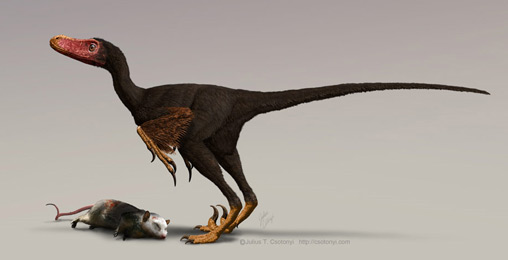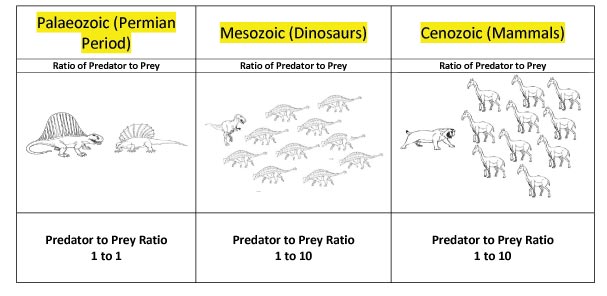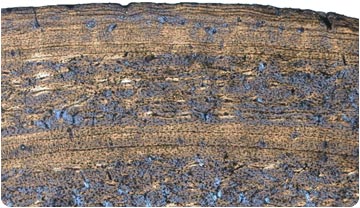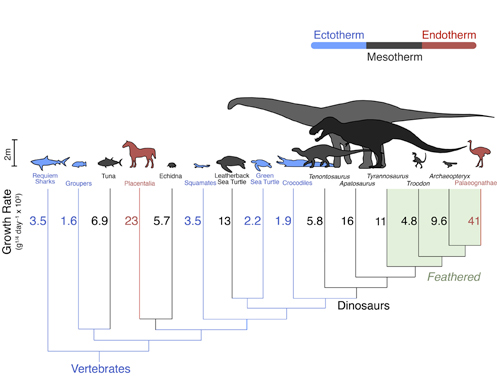Goldilocks and Dinosaurs (Warm-blooded/Cold-blooded Debate)
Warm-blooded or Cold-blooded Dinosaurs?
In the fairy tale Goldilocks and the three bears our heroine comes across three bowls of porridge in the bear’s house. One bowl is too cold, another too hot, but the third is just right at a temperature somewhere in between. Thanks to an exhaustive study undertaken by a team of American researchers, palaeontologists can apply the “Goldilocks analogy” to the study of dinosaur metabolism. In a paper, published in the academic journal “Science”, the authors suggest that the Dinosauria took a “middle of the road” approach when it comes to body temperature.
This new research suggests that dinosaurs were not cold-blooded like crocodiles, nor were they warm-blooded like us, but they were mesothermic, somewhere in-between.
Were the Dinosaurs Warm-blooded or Cold-blooded or Somewhere In-Between?
Picture credit: Julius Csotonyi
The debate as to whether dinosaurs were cold-blooded (ectothermic) or warm-blooded (endothermic) has gone on for many decades. The first scientists and academics to study dinosaur fossils concluded that these reptiles must have been cold-blooded, like extant reptiles today. Cold-blooded is a very misleading term, the blood of dinosaurs and other ectotherms would not have been cold, this term refers to the fact that organisms which are cold-blooded have no internal mechanism for regulating the temperature of their bodies. They rely on external sources of heat to warm them up and to make them active. For example, lizards and snakes bask in the sun to become warm.
When these creatures get too hot, they seek shade. These ectotherms are capable of bursts of energy, a freshwater crocodile from Australia can easily outrun a person over rough terrain for a short distance, but such strenuous activity is often followed by long periods of rest and recovery.
Warm-blooded organisms, the endotherms, are able to regulate their own body temperature. They can be active whatever the external temperature. The food consumed by mammals and birds enables them to generate heat internally, this means that these sorts of animals are generally much more active than today’s reptiles and amphibians. Endotherms pay a high price for such an ability. Their metabolisms are much higher so they need much more food than an equivalent sized ectotherm.
Predator to Prey Ratios in Previous Studies Suggest Dinosaurs were Endotherms
Picture credit: Everything Dinosaur
A number of research projects have attempted to estimate the ratio of predator species to potential prey preserved in the fossil record. The hypothesis being that if there were a large number of potential prey animals compared to predators this might indicate that those primary and secondary predators may have needed large amounts of food to sustain them. This led to the conclusion that dinosaurs (at least most theropods), were warm-blooded.
New research conducted by University of New Mexico graduate student John Grady in collaboration with colleagues from the Sante Fe Institute and the University of Arizona took a different approach. They assessed the growth rates of extinct and living animals in a bid to provide further insight into the dinosaur warm-blooded or cold-blooded debate. Growth rings were examined in the bones of 381 different animals including 21 different dinosaurs. The idea being that fast growth rates indicates a high metabolism which in turn suggests endothermy.
The database that plotted animal growth rates (ontogeny) and energy use was developed by Grady. He and his colleagues demonstrated that animals that grew quicker required more energy and had higher body temperatures. A benefit of using animals alive today is that such measurements can be taken. When it comes to the dinosaurs, the research team relied on estimated growth rates from palaeontologists who had studied the growth rings identified in fossilised dinosaur bone cut into cross section and examined under a microscope.
Using Dinosaur Bones to Assess Growth Rates
Picture credit: Meike Köhler
Once all the data was plotted, the scientists were able to calculate the rate of dinosaur metabolisms. They concluded that based on this data, dinosaurs were an intermediate form between modern endothermic mammals and ectothermic reptiles.
Commenting on the results, Grady stated:
“Most dinosaurs were probably mesothermic. A thermally intermediate strategy that only a few species – such as the the egg laying Echidna [marsupial] or Great White sharks use today.”
Dinosaurs Found to be Intermediate between Ectotherms and Endotherms
Picture credit: University of New Mexico/Science
The simplified diagram above plots the growth rates and projected metabolisms for typical dinosaurs such as Tenontosaurus (ornithopod), a typical tyrannosaurid (theropod) and Apatosaurus (sauropod) against a number of living vertebrates. Warm-blooded animals are highlighted in red, whilst cold-blooded animals are blue. The dinosaurs (in black), seem to have a growth rate that falls in between the cold-blooded reptiles and amphibians and the warm-blooded mammals. The growth rate of dinosaurs seems matched to living mesotherms such as the Tuna, the Leatherback turtle or the Echidna.
This new study has certainly opened up a new avenue of debate. Intriguingly, the team also looked at the growth rates of feathered dinosaurs and primitive birds, they found that both ancient birds and feathered dinosaurs probably grew more slowly than their modern descendants.
The team proposed that Archaeopteryx, a primitive bird from the Late Jurassic (A. lithographica) took two years to reach maturity, some birds living today which are the same size, the Red-tailed Hawk for example, can reach maturity in six weeks. The team concluded, that whilst dinosaurs did not grow as fast as modern birds or mammals, they did grow significantly quicker than extant reptiles.
Student Grady, went on to add:
“This higher energy use probably increased speed and performance. Mesothermic dinosaurs were likely faster predators or better able to flee from danger than the large reptiles found earlier in during the Mesozoic.”
The research team are to be commended for undertaking such an extensive quantitative analysis. Thanks to their research, scientists can have more confidence in the link between metabolic rate and how quickly animals grow. However, the debate over the Dinosauria and how they lived as a result of the ability or inability to regulate their body temperatures is going to rumble on.
Professor Roger Seymour (University of Adelaide), disagrees with the general conclusions made by the American researchers.
He stated:
“They could find only eight species living today that are mesotherms. Doesn’t that suggest that there’s an adaptive value in being either a good ectotherm or a good endotherm, but not in the middle?”
The Dinosauria evolved into a huge variety of forms from massive sauropods to arboreal, theropods, it is quite likely that with such a diverse group that one metabolic strategy “fits all” over simplifies the situation.
One of the issues very large dinosaurs such as Apatosaurus and Diplodocus had was not trying to keep warm, but trying to lose heat from their massive bulk. Such herbivores had vast stomachs and very long intestinal tracts. As plant material was broken down, it very probably fermented and gave off heat. Since for much of the Mesozoic, the Earth was hotter than it is today, keeping cool could have been a major problem for a large dinosaur.
Everything Dinosaur has reported on a number of scientific papers published regarding this debate, to read an article detailing further research into the warm-blooded/cold-blooded controversy by another American team that used analysis of dinosaur teeth to conclude that these animals (some of them at least), might have been endotherms: Dinosaurs Ectotherms or Endotherms?





